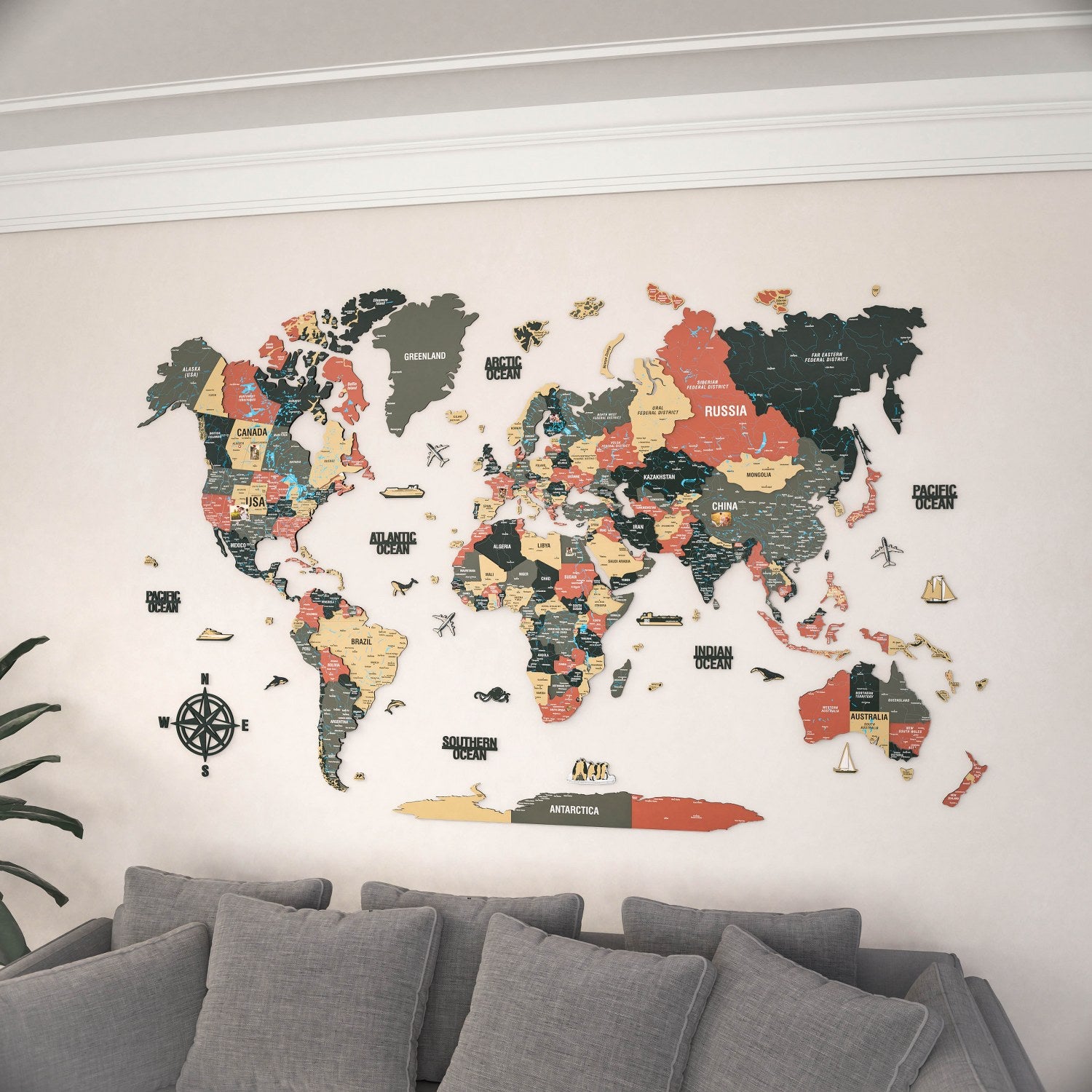Wooden Map: Unique Home Decor Inspired by Nature and Adventure

A Wooden Map is more than just a decorative piece; it embodies craftsmanship, history, and personal stories that transcend simple geography. For travelers and ocean enthusiasts, nautical maps crafted from wood serve as timeless artifacts that evoke the spirit of maritime exploration. They offer a tactile connection to the vast, mysterious world beneath and beyond the seas, blending artistry with a sense of adventure. In this article, I will take you on a journey into the captivating realm of wooden nautical maps, sharing personal insights and detailed explorations into the artistry, history, and emotional resonance of these unique creations.
My Journey into the World of Wooden Maps
A Chance Encounter

My fascination with wooden maps began serendipitously during a vacation that led me to a quaint, rustic shop nestled in a coastal town. As I wandered between shelves lined with vintage trinkets and handcrafted artifacts, a curious wooden piece caught my eye. It was a beautifully crafted wooden world map, intricately carved with tiny push pins marking favorite destinations and hidden corners of the globe. Its three-dimensional design and warm hue instantly drew me in, sparking an innate sense of wanderlust.
Standing before that map, I felt an immediate connection to the art form—an appreciation for the craftsmanship and the stories embedded within each wooden segment. It wasn’t just decoration; it was a gateway to adventures past and future, a tactile reminder of journeys that had shaped my worldview. That chance encounter marked the beginning of my deep dive into the captivating universe of wooden maps—specifically, nautical maps that beckon with tales of seas, exploration, and maritime discovery.
Unpacking the Charm

What I didn’t anticipate was how much emotion and history could be encapsulated within a wooden map. Each carve and cut carried meaning—whether it represented coastal outlines, archipelagos, or famous seas. The detailed craftsmanship illustrated not only the geographic features but also the cultural and historical significance of maritime regions.
For example, many nautical maps emphasize navigational routes, dangerous reefs, and historically significant ports, transforming a simple map into a cultural artifact. They serve as visual narratives of seafaring adventures, shipwreck tales, and maritime trade routes that have shaped civilizations. As I studied the maps further, I realized that these wooden creations become personal time capsules—connecting travelers, explorers, and history buffs to the stories of the oceans. Owning or even creating a wooden nautical map is embracing a piece of maritime heritage, a cherished reminder of our collective fascination with the great blue.
The Process of Creation

Diving deeper, I became intrigued by the meticulous process behind crafting a wooden map. The artistry isn’t merely about cutting shapes; it involves a series of skilled steps requiring precision and a deep understanding of both woodworking and geography. Artisans select the right type of wood—often those with rich grains and durability—to bring out the map’s aesthetic. Common choices include oak, walnut, or maple, each imparting a distinct character to the finished product.
The engraving and carving process demands patience and accuracy. Using specialized tools, artisans meticulously cut out coastlines, borders, and other intricate details layer by layer. Some artisans employ laser engraving for precise detailing, while others prefer traditional hand-carving, adding a unique touch to each piece. These steps transform raw wood into a detailed, three-dimensional blueprint of the world or specific regions, especially if they focus on maritime areas like the Caribbean, Mediterranean, or coastal U.S. regions.
One of the most fascinating aspects is the way artisans incorporate character into each map. Edges may be subtly beveled, and the surface sanded to smoothness or left with a natural rough finish. This attention to detail elevates the wooden map from simple cartography to a work of art—something that can be passed down through generations or serve as an inspiring centerpiece.
Finding My Own Creative Spark

Inspired by the artisans I met and the craftsmanship I observed, I decided to embark on my own creative journey—trying to craft a wooden nautical map. I started by sketching my favorite maritime routes and noting significant ports that had personal meaning. The process was challenging yet fulfilling; it pushed my patience and precision, forcing me to appreciate the craftsmanship involved in each piece.
As I worked, I realized that creating a nautical map is more than a craft; it’s a form of storytelling. Each cut, each detail reflects choices and memories—an act of preservation. The tactile process of working with wood and visualizing maritime territories brought a new depth of appreciation. It also reignited my sense of adventure and inspired me to plan future travels to explore more of the world’s coastlines. The journey from sketch to finished piece was a lesson in creativity, patience, and the importance of preserving stories through art.
The Artistic and Cultural Significance of Wooden Nautical Maps

The Artistry of Crafting Maritime Maps

Crafting a wooden nautical map is an art form that requires a harmonious blend of technical skill, artistic vision, and historical knowledge. Master artisans often spend years perfecting their craft, understanding how to bring geographic accuracy into harmonious dimensional relief. The artistry not only lies in the precision of the shapes but also in the presentation—the choice of wood, the finishing touches, and how these elements evoke emotion.
Many wooden nautical maps feature layered construction, where different pieces of wood are assembled in a way that highlights depth and detail—creating a 3D effect that mimics the undulating ocean surface or the rugged coastlines. Some artisans incorporate elements such as tiny ships, lighthouses, or compass roses, adding to the map’s visual richness. The care taken in detailing turns these maps into visual stories—visual gateways into maritime history, exploration, and discovery. They encapsulate a timeless appeal, blending natural materials with human ingenuity.
Connecting Culture with Geography
Nautical maps carved from wood foster a deeper cultural connection to the seas. They honor the age of exploration, where brave sailors embarked on voyages that expanded the known world. Historically, such maps served as navigation tools, guiding ship captains through treacherous waters with the help of detailed coastlines and ocean currents.
Modern wooden nautical maps celebrate this heritage, transforming functional navigation into an artful display of maritime pride. For coastal communities and maritime enthusiasts, these maps evoke a sense of belonging and shared history. They symbolize exploration, adventure, and the quest for understanding the vastness of the ocean. Additionally, they serve as educational tools, inspiring new generations to appreciate the importance of seafaring and maritime safety.
Adding a Personal Touch
Incorporating personalized elements into a wooden nautical map enhances its emotional value. Some owners embed the coordinates of their most memorable voyages or frame a map with symbols representing personal milestones—like the location where they took their first sea voyage or where loved ones hold a special place in their hearts.
The wooden map thus becomes a visual diary, a testament to personal journeys, family heritage, or dreams of future adventures. This personal touch amplifies its significance—transforming it from a mere decor piece into a cherished family heirloom or a motivational artifact. These maps are often selected as gifts for loved ones who share a passion for the ocean, making them even more meaningful and memorable.
The Influence of Wooden Nautical Maps in Home Decor and Collecting
Stylish Integration into Living Spaces
Today, wooden nautical maps find a prominent place in home decor, especially in homes with coastal themes or a maritime vibe. Their natural wood tones bring warmth and texture to walls, creating a focal point that invites curiosity and admiration.
Many homeowners opt to feature a large wooden world map with nautical accents—such as ship models, lanterns, and vintage compasses—to create an immersive maritime atmosphere. These maps complement a variety of decor styles, from rustic to modern minimalism, adding character and a story to every room. When integrated thoughtfully, a nautical map becomes more than artwork; it’s an experiential element that sparks conversation and reminisces about past travels.
Collecting and Appreciating Wooden Nautical Maps
Collecting these maps has grown in popularity among enthusiasts who appreciate the craftsmanship and history behind each piece. Limited editions, handcrafted works, and vintage maps are highly sought after, often appreciated for their uniqueness and artistry.
Some collectors focus on specific regions or themes—like Mediterranean coasts, the Caribbean islands, or historic sea routes—creating curated collections that tell a broader story of maritime adventure. These wooden maps are often displayed prominently in private collections, museums, or maritime-themed establishments, serving as tangible links to humanity’s collective passion for the seas. They are treasured not only for their aesthetic appeal but also as investments in cultural history and craftsmanship.
Conclusion

In exploring maritime adventures through wooden nautical maps, I discovered a fascinating blend of craftsmanship, history, and personal storytelling. These wooden creations serve as bridges that connect us to the age of exploration, the mystery of the oceans, and the journeys that define our lives. Whether used as inspiring decor, educational tools, or cherished heirlooms, they encapsulate the timeless allure of the sea.
As I continue my own journey of travel and discovery, I find that having a wooden map—especially one that highlights maritime regions—reminds me of the endless possibilities that await beyond the horizon. These maps are more than decorative objects; they are gateways to adventure, history, and personal memories that enrich our appreciation of the world’s most mysterious and captivating environment—the seas. Whether you are a seasoned sailor, a history buff, or a travel lover, a wooden nautical map invites you to embark on your own voyage, one beautifully crafted detail at a time.
